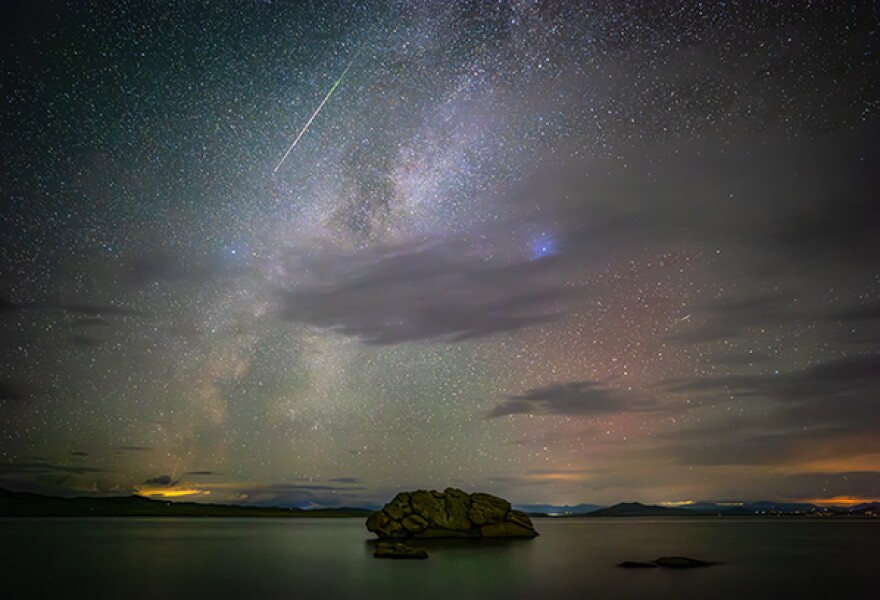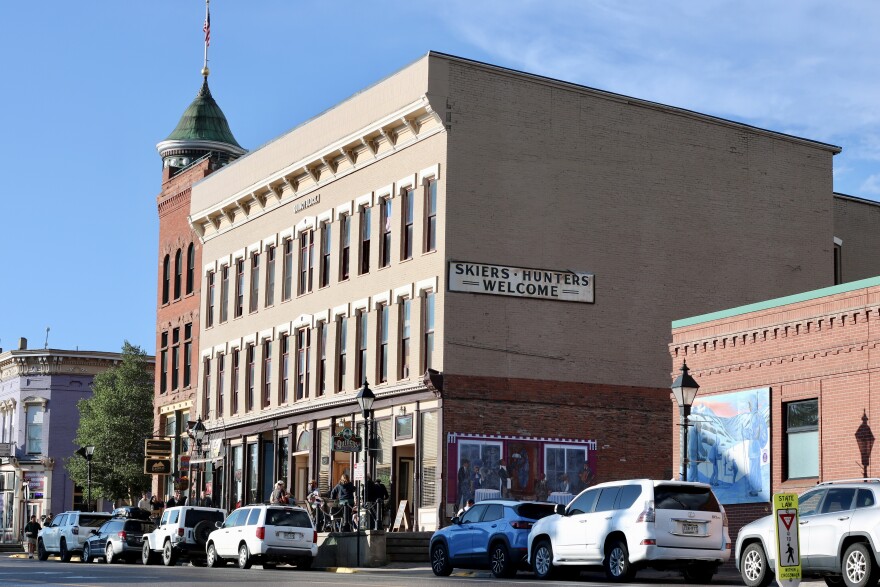Twilight seemed to go on forever beside the mountain lake where about 20 people were patiently waiting for the stars. But clouds that had threatened rain earlier were beginning to give way to a crisp navy sky, as tiny white dots revealed themselves.
"The Big Dipper has just poked out a little bit, and we’re going to have to really crane our necks," said Joan Veilleux, one of the Forest Service rangers leading this "star party" at a campground in Twin Lakes, Colo., near Leadville.
Attendees gazed up and released a chorus of "oohs" and "aahs." Leo Pareti, another ranger and an astronomy expert, set up a high-powered telescope, focused on a pair of stars orbiting around each other.
"Oh, I can see!" one stargazer exclaimed, peering into the eyepiece.

The sky could soon get even darker around here because there’s an effort underway to reduce the glow coming from streetlights and storefronts in town. Leadville’s leaders are applying for a certification through the nonprofit organization DarkSky International that reflects its efforts to reduce light pollution.
"We are using light excessively and incorrectly where we live and work," said Michael Rymer, the community programs manager for DarkSky International.
Artificial light is known to affect human and animal health — throwing off circadian rhythms, keeping urban birds up later and hindering dung beetles' nighttime navigation.
Due to light pollution, 4 out of 5 people living in North America can’t see the Milky Way. But more than 230 places have joined DarkSky's effort to reverse this trend.
"We are not trying to get rid of all light altogether," Rymer said. "We're trying to use light more responsibly.
The Mountain West plays a big role. Flagstaff, Ariz., became the first-ever dark sky community in 2001. Central Idaho is home to the only dark sky reserve in the U.S. and Utah has the highest concentration of dark sky places globally. Leadville wants to join the ranks.
Compared to ritzy ski destinations nearby, Leadville is more of a working town with an economy historically driven by mining. But people flock to the area to climb 14,000-foot peaks — the highest in the state — and for a grueling ultra trail race. Outdoor recreation reached new levels during COVID.
"People are naturally drawn to this place because of our access to the outdoors," said Adam Ducharme, the tourism and economic development director for Leadville and Twin Lakes.
He thinks having recognition from DarkSky would help Leadville attract more visitors, specifically those who value conservation.

"Rather than just sort of trying to pave paradise and put up a parking lot, it’s a lot more about ‘Hey, we are Leadville-Twin Lakes; come experience the beauty of this place,'" Ducharme said.
The state of Colorado shares this vision. A few years ago, the legislature directed the state's tourism office to set up a dark sky grant fund and mentor program, putting $35,000 behind the effort. Since then, the Colorado Tourism Office has helped several communities apply for certification and is making a big push to get more state parks on board. It’s helping applicants through the process, which can take years.
Now, Colorado has 35 more dark sky places in the pipeline — almost double the 19 already certified.

On a chilly evening this past spring, Ben Banet held a sensor beneath a lamppost in Leadville.
"You can just hold this up and press the button," Banet explained.
He’s the town’s dark sky mentor, paired by the state's program. Banet was walking volunteers through a lighting inventory, stopping at different streetlights to take measurements and rattling off numbers in units ranging from Kelvin to foot-candles. He noted whether lights were shielded down or pointed up at the sky, and how warm or cool they were (blue light scatters more and increases skyglow).
The inventory, required for DarkSky certification, will eventually resemble a catalogue of all the public outdoor lights. Collecting the data will tell Leadville how it can minimize light pollution.
"We probably don’t need three lights on that one pole," Banet gave as an example, as he stared up at a cluster of bulbs outside the courthouse.

DarkSky gives communities a grace period to reach compliance. Some of the requirements are outlined in an ordinance, which the city would need to pass for the certification. In addition, communities are required to submit reports and take darkness measurements annually, and host educational events.
Leadville is a small city, about one square mile. Outside its limits are places with brighter lights, including ski resorts and a mine. Rymer said population growth in urban areas, and brightening lights overall, can affect places already certified by the organization.
"There's development around those places that is really outpacing the work in reducing light pollution," he said.
Still, he said the interest in protecting the night skies is palpable.
"If we were to certify every project that was ongoing today, we double the amount of dark sky places in the world," he said.

Plus, at the least, Leadville’s efforts could help illuminate the stars for campers nearby.
At the Twin Lakes "star party," Bruce and Beth Hicks were huddled together, matching constellations mapped on their phone with those hanging above them.
"This is pretty spectacular," Bruce said. "There’s a lot of stars out."
Some stargazers were visiting Colorado from Illinois and Texas. The Hicks came from Florida, on an RV road trip, to hike some of mountains stretching above the horizon. They seek out wild places like this when they travel.
"The light pollution is so low that we see so much more than we do at home," Bruce said.
They’re exactly the type of people Colorado wants to attract through its dark sky push. And maybe, Rymer hopes, when they return home, they’ll spread the message about dimming the lights.
Correction: This story initially misspelled the name of Joan Veilleux.
This story was produced by the Mountain West News Bureau, a collaboration between Wyoming Public Media, Nevada Public Radio, Boise State Public Radio in Idaho, KUNR in Nevada, KUNC in Colorado and KANW in New Mexico, with support from affiliate stations across the region. Funding for the Mountain West News Bureau is provided in part by CPB.





